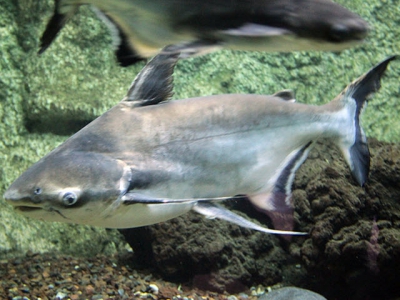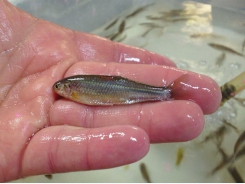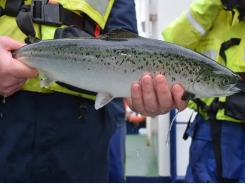Effects of Bamboo Charcoal Added Feed on Reduction of Ammonia and Growth of Pangasius

A 50-day feeding trial was conducted to determine the effects of dietary bamboo charcoal (BC) on ammonia (NH3-N) excretion and growth performances of Pangasius hypophthalmus, write M Sadiqul Islam et al, Bangladesh Agricultural University.
There is a great potential for Pangasius hypophthalmus in Bangladesh. It is very much demandable in local markets because of its lower market price. The vast majority of poor people consume P. hypophthalmus as this fish is delicious and tasty due to its high fat content. Moreover, the climate, water and soil conditions of Bangladesh have proved totally suitable for P. hypophthalmus production and it is one of the most suitable catfishes for rearing in ponds. Pangasius culture has proved itself as a profitable enterprise due to year round production, quick growth and high productivity. In addition, it can be stocked at a much higher density in ponds compared to other cultivable species.
However, costly feed and low market price has slowed progress in farming of this fish. In addition, due to high accumulation of nitrogenous waste products that is toxic to fish considered as a limiting factor for growth and survival of fish are affecting the culture of this species. One of the sources of this nitrogenous waste (e.g. ammonia) is from the supplemented feed that fed to fish. An effective way to reduce the waste load is to modify aqua feeds with the aim of reducing excretion of nitrogen, phosphorus and total solids relative to fish growth.
Therefore, several efforts have been made to produce high quality animal products without using medicines and to reduce environmental contamination by efficient utilization of natural substances. Some of these natural substances (e.g. wood charcoal, bamboo charcoal, coconut shell charcoal etc.) are not cited in the scientific literature, but are used locally. Like wood charcoal bamboo charcoal (BC) is also an activated charcoal made by dry distillation of a thick-stemmed bamboo and powder of which is known as a universal adsorbent, because it can bind with variety molecules since it contains a complex network of pores of various shapes and sizes.
Now-a-days, BC has been used in animal feed formulation as an additive because they absorb ammonia and nitrogen, and activates the intestinal function through eliminating the poisons and impurities from the gastrointestinal tract of land animals. Utilization of charcoal from wood or bamboo may provide an economical way to eliminate noxious substances because of their cheaper cost.
Moreover, BC is considered to have a higher adsorption capacity than wood charcoal because it has about 4 times more cavities, 3 times more mineral content and 4 times better absorption rate. Reports have clarified the ammonia adsorption effect of BC in aqueous solution, and dietary addition of BC effects on digestion, nitrogen retention and excretion of growing goats. They also found that goats fed a diet containing 0.5 g of BC per kg of body weight grew faster than the controls. Recently it was found that bamboo charcoal boosts tilapia growth. However, very limited studies about BC in aquatic animal nutrition as a feed ingredient have been conducted.
Therefore, the major purpose in the present study was to assess the effectiveness of dietary BC supplementation on growth performance of P. hypophthalmus and elimination of ammonia nitrogen excretion from the water during study period.
Results
Water quality parameters
Ammonia: The ammonia (NH3-N) values of water ranged from 0.02 ± 0.01 to 2.06 ± 0.12 mg/l during the study period. Significantly (P < 0.05) higher value of ammonia which is not good for fish was found in the control while lowest value which is suitable for fish was found in T3 (2% BC) (Figure 1).
pH
The pH values of water ranged from 6.89 ± 0.11 to 7.81 ± 0.09 during the study period. The highest level of pH was found in the control while the lowest level of pH was found in T3 (2% BC). There were significant differences (P<0.05) between the control and T3. A proportional relationship between pH and ammonia (NH3-N) concentration were also observed during the study period (Figure 2).
Dissolved oxygen
During the study period dissolved oxygen content of water ranged from 4.58 ± 0.32 to 5.97 ± 0.09 mg/l. The highest value 5.97 ± 0.09 mg/l was found in T3 which was significantly (P<0.05) higher than the control. An inverse relationship between dissolved oxygen and ammonia (NH3-N) concentration were observed during the study period (Figure 3).
Growth parameters
As shown in Table 3 the maximum growth enhancement was noticed at the 2% BC supplementation level. However, fish groups that received dietary BC from 0.5 to 2% level showed higher values of weight gain, SGR and FCR than the control. No significant differences in final length and length gain were observed between fish fed BC containing diet. It was also seen that the survival rates of P. hypophthalmus under the trail treatments were significantly (P<0.05) higher than the control. In an experiment in the earthen pond our study showed that 1.5% BC supplementation level was suitable for the maximum growth enhancement (data not shown) (Table 3).
Values are presented as mean ± SE. Values in the same row having different superscript letters are significantly different (P<0.05). The lack of superscript letter indicates no significant differences among treatments.
Mean weight gain=mean final weight (g)-mean initial weight (g);
Mean length gain=mean final length (cm)-mean initial length (cm);
% Weight gain=(final body weight−initial body weight)×100/initial body weight;
% Length gain=(final body length−initial body length)×100/initial body length;
Specific growth rate (SGR)=(Log final body weight−Log initial body weight)×100/feeding period;
Feed conversion ratio (FCR) = feed fed/live weight gain;
Survival rate (%)=No. of fish harvested ×100/No. of fish stocked.
Histological observation
Intestine of P. hypophthalmus of all treatments had almost normal structure but there was slight change in the villus height and lumen area of those intestines. It was observed that villus height was increased and consequently lumen areas of those intestines were decreased with increasing BC supplementation level (Figure 4).
Discussion
Water quality parameters
One important objective of this study is to determine whether the ammonia nitrogen could be reduced by dietary BC. Some studies have reported on the ammonia nitrogen excretion of Japanese flounder (Paralichthys olivaceus) [12-15]. In the present experiment, the maximum ammonia (NH3-N) concentration was found in the control while minimum concentration was recorded at T3 and concentration increased with decreasing BC supplementation level. This result showed the dose-related effect of dietary BC on ammonia concentration.
During the study period a relationship among ammonia, pH, and dissolved oxygen were observed. In the control, ammonia and pH values were high and DO was low. It was found that ammonia and pH were decreased but DO was increased with increasing BC supplementation level and the lowest value of ammonia was found in T3 where the higher level of BC (2%) was supplied. These results indicated that the dietary BC supplementation could be a potential feed additive to eliminate the ammonia from the culture system.
Growth performances
Based on the growth data, the optimum dietary BC supplementation level for the P. hypophthalmus was found to be 2% of the diet. The maximum mean final weight was 3.68g in T3 where higher level of BC was supplied. The minimum mean final weight was 2.89 g in the control where 0% BC was supplied. Again the maximum mean final length was 7.1 cm observed in T3 and the minimum mean final length was 6.37 cm observed in the control. However, our experiment in the earthen pond indicated a little bit lower concentration of BC (about 1.5%) than the aquarium was the optimum for the growth of P. hypophthalmus and elimination of ammonia (data not shown).
The present finding was less than that found in study where the highest weight gain was obtained at 4% BC supplementation in tiger puffer fish. Although it was found 0.5% BC was suitable level for optimum growth of juvenile flounder. These results indicated the species-related effect of dietary BC on growth, and it might be because of the differences in digestion and feeding behaviors of these species. In the Aigamo ducks it was found that the highest mean final weight gain was in 1% SB (mixture of bamboo charcoal powder and bamboo vinegar solutions) group.
In the present experiment the mean weight gain of P. hypophthalmus in different treatments varied from 1.71 to 2.50 g. The highest mean weight gain was found in T3 while the lowest mean weight gain was observed in the control. Again the highest mean length gain (3.46 cm) was found in T3 and the lowest mean weight gain (2.73 cm) was found in the control. In white leghorn hens (Gallus domesticus) the highest weight gain was observed in case of 0.5% of BC supplementation whereas in Aigamo ducks the mean weight gain of 1% SB group was 8% heavier than the control group.
The higher percent weight gain was found in T3 and it was 212.46% while the lower percent weight gain was found in the control which was 145.32%. Again the higher percent length gain was 95.41% which was found in T3 and the lower percent length gain was 75.23% which was found in the control. More or less similar type of percent weight gain was observed in Japanese flounder by.
The specific growth rates of our studied fish under different treatments were varied from 0.73 to 0.97%. SGR value was higher in T3 where BC level was higher (2%) and SGR value was lower in control where fish reared without BC. SGR were observed 0.02 to 0.68% in P. hypophthalmus using 35-40% protein containing feed. The result obtained in our study was much lower than that (3.09 to 3.51%) was found by in Thai pangas. The FCR under different treatments ranged from 2.36 to 3.44. The improved performance of FCR was observed at 2% BC containing diet.
Our findings indicated that the dietary BC supplementation could be a potential feed additive to enhance the growth of P. hypophthalmus and supports research in tiger puffer and other studies that reported growth in goats, in broiler chicks, and in Japanese flounder.
Histological studies
During the experiment it was observed that, intestine of P. hypophthalmus of all treatments had almost normal structure. The villus height and villus area of intestines of same treatment were almost in similar structure but there was a slight change in the internal configurations of intestines of different treatments. It was also observed that villus height was increased and lumen area was decreased with increasing BC supplementation level. Increased height of intestinal villi means a greater surface area for nutrient absorption.
Greater villus height and increased cell mitosis numbers in the intestine are indicators of activation of the function of the intestinal villi. Furthermore, increased villus size was also associated with activated cell proliferation in the crypt and provided more surface area for nutrient absorption and thus improved nutrient digestibility. These reports suggest our findings that the increased villus height and decreased lumen area in BC supplemented fish would be multiplicatively stimulated by the influence of BC.
Có thể bạn quan tâm
Phần mềm

Phối trộn thức ăn chăn nuôi

Pha dung dịch thủy canh

Định mức cho tôm ăn

Phối trộn phân bón NPK

Xác định tỷ lệ tôm sống

Chuyển đổi đơn vị phân bón

Xác định công suất sục khí

Chuyển đổi đơn vị tôm

Tính diện tích nhà kính

Tính thể tích ao hồ




 How farmers can make more money in catfish…
How farmers can make more money in catfish…  Are organic farmed salmon more susceptible to sea…
Are organic farmed salmon more susceptible to sea…